The Scar-Crow Men, Faustus, and Wizards: Three Posts
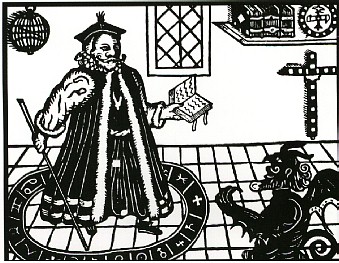 This week I read an advance copy of the second book in Mark Chadbourn’s series of espionage-fantasy-adventure novels, Swords of Albion. The Scar-Crow Men begins with the first performance of Christopher Marlowe’s play Doctor Faustus, and the story of the novel and the story of Faust end up connecting in a number of ways. It got me thinking about Faust, and why the story of Faust has flourished in the centuries since Marlowe wrote, and how many different ideas about wizards there really are.
This week I read an advance copy of the second book in Mark Chadbourn’s series of espionage-fantasy-adventure novels, Swords of Albion. The Scar-Crow Men begins with the first performance of Christopher Marlowe’s play Doctor Faustus, and the story of the novel and the story of Faust end up connecting in a number of ways. It got me thinking about Faust, and why the story of Faust has flourished in the centuries since Marlowe wrote, and how many different ideas about wizards there really are.
So this post breaks down into three posts, offering ruminations on the book, on Faust, and on wizards.
I — A Review of The Scar-Crow Men, by Mark Chadbourn
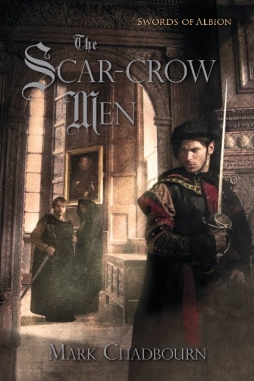 When I read the first book in the Swords of Albion series, The Silver Skull, I was disappointed in a number of aspects while at the same time acknowledging that certain things were done well. I think the second book does what a sequel’s supposed to do; it returns to the experience of the first book, while extending the story and finding new areas to explore. It feels like the first novel in the series, and if you liked that book, you’ll probably like this one. Personally, I thought that it was stronger in a number of ways, but that some of what made it stronger also blunted some of the more effective aspects of the first book.
When I read the first book in the Swords of Albion series, The Silver Skull, I was disappointed in a number of aspects while at the same time acknowledging that certain things were done well. I think the second book does what a sequel’s supposed to do; it returns to the experience of the first book, while extending the story and finding new areas to explore. It feels like the first novel in the series, and if you liked that book, you’ll probably like this one. Personally, I thought that it was stronger in a number of ways, but that some of what made it stronger also blunted some of the more effective aspects of the first book.
The book juggles a number of plot threads. A diabolical presence disrupts the first performance of Christopher Marlowe’s new play, Doctor Faustus, about a scholar who makes a deal with the devil for knowledge and power; the playwright himself soon turns up dead. Marlowe was a friend and colleague of Will Swyfte, England’s greatest spy, secretly dedicated to preserving the country against the machinations of the supernatural Unseelie Court.
Is Marlowe’s death the superficial case of assault that it appears? Or is there something more going on? Are the Unseelie Court back to their old schemes? Swyfte sets out to investigate, and soon ends up embroiled with a demonic mass-murderer in an insane asylum, spies in the pay of a political rival at the English court, a mysterious red-haired woman who knows more than she lets on, and, inevitably, agents of the Unseelie Court.
He also has to solve Marlowe’s last riddle, which has to do with the script of Faustus. This means Chadbourn gets to work lines from the play into the novel, helping to give his book weight, a sense of thematic direction. It also, on a plot level, helps set up some of the supernatural manifestations in the novel — particularly a curse weighing on Swyfte.
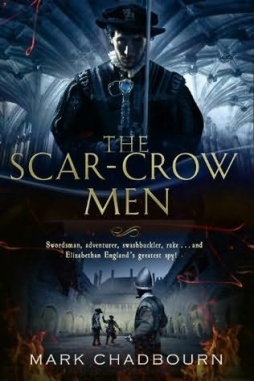 I think the book gains a lot tonally from the use of the Faust tale. Faustus is essentially a horror story, and Chadbourn’s story is I think essentially horrific. In retrospect, the first novel mixed elements of espionage, fantasy, adventure, and horror, and the result felt heterogenous, an uneasy juxtaposition of tones and genre. The Scar-Crow men feels more focussed, more securely what it is — a horror-fantasy with a historical setting, reminiscent of Tom Holland.
I think the book gains a lot tonally from the use of the Faust tale. Faustus is essentially a horror story, and Chadbourn’s story is I think essentially horrific. In retrospect, the first novel mixed elements of espionage, fantasy, adventure, and horror, and the result felt heterogenous, an uneasy juxtaposition of tones and genre. The Scar-Crow men feels more focussed, more securely what it is — a horror-fantasy with a historical setting, reminiscent of Tom Holland.
On the other hand, along with that clarity of identity comes fewer of the well-staged adventure set-pieces that stood out in the first book. In a lot of ways this book feels as though it has a smaller scale. On the whole it’s more consistent, but less explosive. I think the plot’s generally less inventive, and much more predictable. Sub-plots are developed more sporadically and seem less integrated into the main story, and the climax to Will’s investigation feels rushed.
As before, the writing’s uninvolving, and the characters flat. There is at least one formidable woman in the book, unlike the first novel. She’s a sometimes-ally sometimes-enemy for Will; a stock character, but then so are most, if not all, of the characters in the book.
I had some problems with the first book’s presentation of the mentality of the Elizabethan Age, specifically the way it presented Elizabthans as relatively modern, disbelieving in magic and elfs. I thought it was inaccurate, and more to the point, took away something that could have been a real point of distinction for the story. That objection doesn’t really crop up here. The use of the Faust story helps ground the book in real Elizabethan culture; it feels more natural.
Overall, then, the plotting’s not as sharp, but the setting’s more fully-realised. The characters and prose are much the same, but the tone’s more consistent. It feels like the first boook, but is also new and distinctive. It’s adventure fiction, aiming at being a page-turner, and more-or-less succeeds at that. It’s not the most gripping tale, mostly because the prose is so bland, but it’s a competent and fairly inventive yarn.
II — Some Thoughts on the Subject of Doctor Faustus
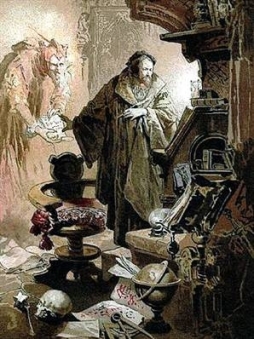 Chadbourn’s novel started me thinking about Faust, and the resonance of the Faust story. At first glance, Faustus seems like the quintessential Renaissance character, symbolic of the tensions and fears of that age. But he’s lasted supremely well. The character’s been reinterpreted several times over the years in a range of media, given slightly new symbolic freight without changing the basic notion. Which suggests a couple of things.
Chadbourn’s novel started me thinking about Faust, and the resonance of the Faust story. At first glance, Faustus seems like the quintessential Renaissance character, symbolic of the tensions and fears of that age. But he’s lasted supremely well. The character’s been reinterpreted several times over the years in a range of media, given slightly new symbolic freight without changing the basic notion. Which suggests a couple of things.
One is that perhaps people really don’t change that much over time, and so any character who represents his own age can be made resonant in any age. Another is that the basic tensions that made Faustus a mythic figure in the sixteenth century may still be present in the twenty-first. Put these two things together, and they suggest a third thing: that the Renaissance, or Early Modern era, still has meaning for us today — with all its allegories, its fluid invention, and its sense of myth as living reality.
But what is this myth of Doctor Faustus? Who is he, and where did he come from? What, in the end, does he mean to us?
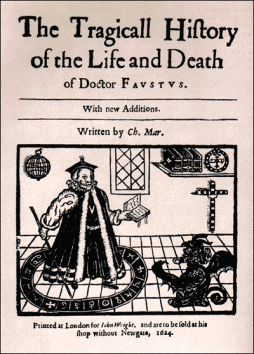 Let’s start with some dates. In 1587 a chapbook started to circulate in Germany, telling the story of a magician who made a deal with the devil. It went through fourteen editions, possibly more, between 1587 and 1593. The chapbook was translated into English in 1589 (and at around the same time into French, Dutch, Danish, and Czech), and that translation at some point inspired playwright Christopher Marlowe to write a tragedy putting the story of Faust on the stage. It’s impossible now to know exactly when Marlowe wrote the play; the evidence is in conflict. He died in 1593, and the play was definitely performed in 1594, but almost certainly had been staged before then.
Let’s start with some dates. In 1587 a chapbook started to circulate in Germany, telling the story of a magician who made a deal with the devil. It went through fourteen editions, possibly more, between 1587 and 1593. The chapbook was translated into English in 1589 (and at around the same time into French, Dutch, Danish, and Czech), and that translation at some point inspired playwright Christopher Marlowe to write a tragedy putting the story of Faust on the stage. It’s impossible now to know exactly when Marlowe wrote the play; the evidence is in conflict. He died in 1593, and the play was definitely performed in 1594, but almost certainly had been staged before then.
The story in Marlowe’s play, largely repeated from the chapbook, has Doctor Johann (or John) Faustus, a learned professor at the University of Wittenberg, summon a devil to gain power and knowledge. The demon he calls, Mephistophilis, has him sign a contract in blood, according to the terms of which Mephistophilis is to serve Faustus for twenty-four years, then take him down to hell, body and soul. Most of the play takes place over those years, as Faustus exploits Mephisto’s powers — playing practical jokes on the Pope, calling up the spirit of Helen of Troy, interrogating Mephistophilis on the nature of reality, and establishing himself as a favourite of the Holy Roman Emperor. All the while, the better angels of his nature are calling on him to repent, even as his bad angel urges him onward to damnation.
Between all these things are scenes of knockabout humour featuring Faust’s servant, Wagner, who stole one of his master’s magic books but doesn’t quite know how to use it properly. It’s not impossible we’re missing some of these scenes, or indeed other scenes in the play; the text exists in two forms, both of which may be corrupt, and very likely have been subjected to official censorship. This is clear, though: in the end, the forces of Hell come to claim Faust, who has some magnificant final monologues, but whose soul is inevitably lost.
How did Johann Spies, the writer of the original Faust chapbook, come up with the story? He seems to have based it on a real person. It’s been well established that there was a Johann Georg Faust active in the first half of the sixteenth century. He travelled around, swindling countryfolk and presenting himself as a wizard, the philosopher of philosophers. When he died, legend had it that his soul was dragged down to hell.
 Faust called himself “Magus Secundus”; Alan Moore claims to have found out what this means, and who Faust the first really was, but that won’t be revealed until the publication of The Moon and Serpent Bumper Book of Magic. In the meanwhile, we can say that it seems at least one other figure was confounded with the charlatan Faust: Johann Fust, a German printer affiliated with Gutenberg — his tutor, or his financial backer, or both.
Faust called himself “Magus Secundus”; Alan Moore claims to have found out what this means, and who Faust the first really was, but that won’t be revealed until the publication of The Moon and Serpent Bumper Book of Magic. In the meanwhile, we can say that it seems at least one other figure was confounded with the charlatan Faust: Johann Fust, a German printer affiliated with Gutenberg — his tutor, or his financial backer, or both.
The roots of the Faust story go back much earlier, though. The idea of a compact with the devil can arguably be found in the Bible itself, when Satan tempts Jesus in the wilderness — if not, indeed, in Genesis, when Satan tempts Eve into sin for the sake of knowledge. Saint Jerome and Saint Augustine both talk about compacts with Satan. Saint Basil, in the fourth century, tells a story of a servant of his who struck a deal with Satan. In the sixth century, there was a tale of a man named Theophilus who made a pact with Satan, then repented, and was saved by the intervention of the Virgin Mary.
The idea of the devil-pact took even deeper root in the Middle Ages, becoming a part of the stories of various saints. But it was as the Middle Ages ended that the idea of the compact became tragically potent. Witch burnings were largely a product of the Renaissance, mostly taking place between 1560 and 1630; or, at about the same time the Faust myth developed. Witches were believed to have sold themselves to Satan for magic power, just as Faust had, and it’s certainly likely that folk belief in witchcraft had something to do with the popularity of the Faust myth.
But then, there were other models for the character as well. The historical Faust was only one of many men who claimed to have magical gifts or an interest in esoteric lore. The Renaissance was filled with self-styled magi, and scholars believed to be magi. Cornelius Agrippa, Paracelsus, Johannes Trithemius, and many others were interested in the fields like the occult, alchemy, philosophy, cryptography, mathematics, and other fields which at that time existed on the fuzzy boundaries between the known, the unknown, and the forgotten.
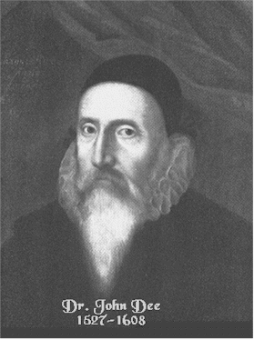 Particularly worth mentioning here are Giordano Bruno and Doctor John Dee. Bruno was a heretic and freethinker, the first man to imagine that the stars were each of them suns like our own. He was burned in 1600, but passed through England in the 1580s and may have influenced Marlowe. A much more certain influence was Dee, Elizabeth’s astrologer and mathematician. Dee’s a fascinating figure, who’s turned up in any number of fictions and songs in recent years; he coined the term “British Empire,” tried to speak with angels, helped oversee British voyages of exploration, seems to have created his own magic system, and built one of the great libraries of his day — which was sacked by a mob at about the time Marlowe was writing his Faustus.
Particularly worth mentioning here are Giordano Bruno and Doctor John Dee. Bruno was a heretic and freethinker, the first man to imagine that the stars were each of them suns like our own. He was burned in 1600, but passed through England in the 1580s and may have influenced Marlowe. A much more certain influence was Dee, Elizabeth’s astrologer and mathematician. Dee’s a fascinating figure, who’s turned up in any number of fictions and songs in recent years; he coined the term “British Empire,” tried to speak with angels, helped oversee British voyages of exploration, seems to have created his own magic system, and built one of the great libraries of his day — which was sacked by a mob at about the time Marlowe was writing his Faustus.
So Faustus incarnates in his person both witch and wizard. Ronald Hutton once described accused witches as being mostly “poor, marginalized, and anti-social”; the typical Renaissance magician was perhaps university-educated, but also frequently poor, or at least dependent on traditional nobility for status. You could say that one was below the mass of the people, while the other was above — but not too far above. Both were outliers, outside of the social norm, outside of the structures that defined most people’s lives.
Important to remember about the early treatments of the Faust legend, I think, is the fact that these are basically popular storytelling forms. Chapbooks were cheap pamphlet-like ephemera, shoddily printed on poor paper, aimed at a lower-class audience; they physically resembled pulp magazines or old comic books, and had roughly the same cultural status. Marlowe’s theatre was deeply populist, played for a penny a show to an audience of apprentices, women, and the poor. In 1589 an English ballad about Faustus was written, the ultimate popular form at the time.
Now, one of the men the Faust story was based on was a printer; and it was in a chapbook, a cheap print form impossible to imagine before the Renaissance, that Faust’s story first appeared. Faust’s, of course, is a German story, and a number of writers have seen it as being in some way connected to the Protestant Reformation; usually, given the anti-Catholic satire in the Faust chapbook, as an early Protestant myth. But it’s also a commonplace to say that the Reformation was spread by print technology, just as the Faust story was. So the tale, in its source and its form, picks up on the advent of printing, of new technology, of new ideas being spread by a new form of communication.
 Marlowe’s play also makes a point of noting that Faustus wasn’t of noble birth: “his parents base of stock”. So the story isn’t a traditional tale of kings or princes or knights; we’re dealing with a man outside of the traditional ruling structures, and relatively low on the great chain of being that gave every living thing a place in a hierarchy stretching from heaven to earth and on down to hell. Faust is, if not a democratic hero, at least a man of the people.
Marlowe’s play also makes a point of noting that Faustus wasn’t of noble birth: “his parents base of stock”. So the story isn’t a traditional tale of kings or princes or knights; we’re dealing with a man outside of the traditional ruling structures, and relatively low on the great chain of being that gave every living thing a place in a hierarchy stretching from heaven to earth and on down to hell. Faust is, if not a democratic hero, at least a man of the people.
So the Faust story has populist roots, derives from the religious conflicts of the times, and both exploits and expresses fears about new technologies then changing Europe. It does more than that, too. Because Faust is a philosopher, he asks Mephistophilis about the nature of the heavens and the earth. So it expresses a perspective on these things, on the Elizabethan world-picture that was in the process of being utterly changed by Copernicus and (a little later) Francis Bacon.
Faustus consciously turns from religion early in the play: “The reward of sin is death,” he tells himself. “That’s hard. … If we say that we have no sin we deceive ourselves, and there is no truth in us.” So why not turn to hell? For Faustus, it’s inevitable anyway. This “devil’s syllogism” was often cited at the time as a contradiction in doctrine, specifically Calvinist doctrine; it’s been explained away, but the point is that Faustus is going beyond Renaissance humanism to a skepticism based on close textual reading.
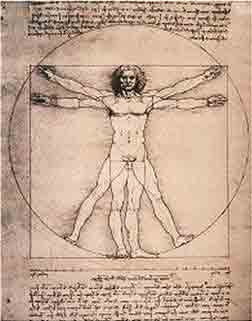 More than that: “The word ‘damnation’ terrifies not him,” Faustus brags of himself, “for he confounds hell in Elysium. His soul be with the old philosophers.” Faust aspires to hell, to spending eternity with the spirits of the pagan thinkers. “Humanism” is a vague word, even in the Renaissance — perhaps especially then — but one can say that it had to do with a revival of pagan learning. The typical humanist didn’t allow the pagan ideas to shake his Christian faith, but Faust was prepared to go further, to throw away heaven for the sake of spending his afterlife with pre-Christian thinkers. So the myth expresses a fear of learning, humanism, and of the revival of paganism; a dread of secularism. At least, as long as we imagine Faust as a villain, or a figure to be feared.
More than that: “The word ‘damnation’ terrifies not him,” Faustus brags of himself, “for he confounds hell in Elysium. His soul be with the old philosophers.” Faust aspires to hell, to spending eternity with the spirits of the pagan thinkers. “Humanism” is a vague word, even in the Renaissance — perhaps especially then — but one can say that it had to do with a revival of pagan learning. The typical humanist didn’t allow the pagan ideas to shake his Christian faith, but Faust was prepared to go further, to throw away heaven for the sake of spending his afterlife with pre-Christian thinkers. So the myth expresses a fear of learning, humanism, and of the revival of paganism; a dread of secularism. At least, as long as we imagine Faust as a villain, or a figure to be feared.
After he makes his pact, Faust wishes for a number of things — a wife, to start with (he changes his mind when Mephisto brings him a female devil), and then several magic books. Among the books, he wants one “where I might see all characters and planets of the heavens, that I might know their motions and dispositions.” The talk of characters and dispositions might recall astrological beliefs, but more likely this touches on the debate over Copernicus’ theory that the earth and other planets revolved around the sun. I imagine that for the Elizabethans this was a profoundly dislocating idea — imagine looking up at the night sky and not knowing what you see, not understanding what the lights in the darkness really are, imagine finding all you thought you knew was wrong down even to the most apparently common-sensical perception. Faustus, though, cuts through the confusion. He’s getting to the truth.
The oldest German Faust chapbook says that Faust traded his soul specifically for knowledge, not unlike Eve: “to search into all the deep things of heaven and of earth.” Marlowe’s Faust, we are told,
To learn the secrets of astronomy
Graven in the book of Jove’s high firmament,
Did mount him up to scale Olympus top,
Where, sitting in a chariot burning bright
Drawn by the strength of yoked dragons’ necks,
He views the clouds, the planets, and the stars,
The tropics, zones, and quarters of the sky,
From the bright circle of the horned moon
Even to the height of the Primum Mobile.
But from this Faust soon slides back into using his powers for jokes and personal gain. The temptation of Faust takes many forms; we see it not only in his giving himself over to hell, but also in what he chooses to do with the gifts he gains thereby.
From an English-speaker’s perspective, The Tragical History of Doctor Faustus comes at the start of the Golden Age of English literature. It stands near the beginning of the great tide of writing, of dramas and poems and romances and essays, that helped transform and immeasurably enrich the English language. Marlowe was a pivotal figure, the first great English playwright (for all that his writing tends to be more memorable for tremendous ranting lines rather than full characters), a profound influence on Shakespeare. Faustus is perhaps his most significant play; so there’s a sense that English could be said to be a Faustian literature, even a Faustian language, shaped by the story just as it was coming to full flower.
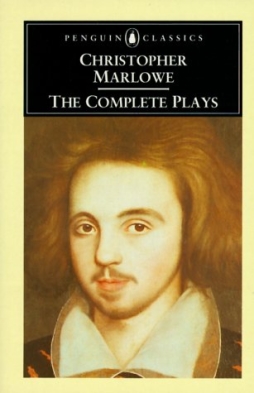 If the meaning of the Faust story was an evil man’s damnation, this would not be a good thing. But Marlowe’s Faustus doesn’t seem to me to be that simplistic. Faust’s got his positive side, and frequently over the course of the play we’re expected to cheer him on, even to empathise or identify with him. There’s as much good as bad in him. There’d have to be, or else his damnation wouldn’t be a tragedy. But by the same token, you end up thinking that there’s some injustice in seeing a remarkable man condemned to eternal punishment; at the very least, there’s an opportunity missed.
If the meaning of the Faust story was an evil man’s damnation, this would not be a good thing. But Marlowe’s Faustus doesn’t seem to me to be that simplistic. Faust’s got his positive side, and frequently over the course of the play we’re expected to cheer him on, even to empathise or identify with him. There’s as much good as bad in him. There’d have to be, or else his damnation wouldn’t be a tragedy. But by the same token, you end up thinking that there’s some injustice in seeing a remarkable man condemned to eternal punishment; at the very least, there’s an opportunity missed.
Marlowe himself was accused of atheism when he lived, and one rival bitterly complained that he “blasphemed with the mad priest of the sun,” which is possibly an oblique reference to Giordano Bruno. It’s certainly possible to read Doctor Faustus as a story that justifies atheism, or at least skepticism. It seems to uphold accepted Renaissance verities, but also can be understood to undermine them. As a myth, it’s appropriately Janus-like, looking two ways at the same time, both ahead and behind.
After Marlowe’s play, the story continued to be retold, in chapbooks and puppet-shows. It continued to speak to new generations, and in time a new version was conceived even greater than Marlowe’s play.
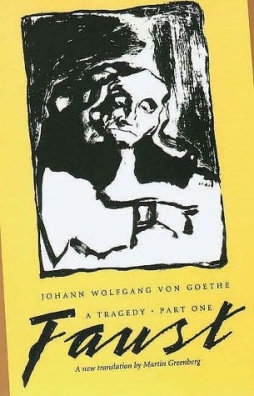 In the late eighteenth century, German literature was finding its voice. A number of writers turned to the Faust story as a powerful German tale. In 1772, Johann Wolfgang von Goethe began writing a verse play based on the myth, a closet drama not intended for the stage. He finished a draft in 1775, then began completely revising it. A fragment was published in 1790, and the finished first part of the play in 1808. He didn’t finish the second part until the year of his death, 1832.
In the late eighteenth century, German literature was finding its voice. A number of writers turned to the Faust story as a powerful German tale. In 1772, Johann Wolfgang von Goethe began writing a verse play based on the myth, a closet drama not intended for the stage. He finished a draft in 1775, then began completely revising it. A fragment was published in 1790, and the finished first part of the play in 1808. He didn’t finish the second part until the year of his death, 1832.
Goethe’s Faust is very different from Marlowe’s, and one of the great works of world literature. The first part follows Faust as he makes his deal with the ubane and charming Mephistopheles; Faust has a few adventures, including spending a night at a witches’ sabbath on the Bare Mountain, and seduces a girl named Marguerite whose fate becomes the dominant theme of much of Part One. Part Two is longer and much wilder, a frantic, kaleidoscopic rush of ideas and images and mythology, a frenetic attempt by Goethe to (among other things) marry north European Gothic culture with south European Classical culture. Faust’s dalliance with Helen of Troy becomes expanded into a full relationship, a marriage, with a peculiar offspring.
Faust, Part Two is a perplexing and fascinating work, deeply mysterious and profound while also flashy, sardonic, and unpredictable. At the conclusion, Faust is saved, as Mephisto is distracted from his efforts to pull him down to hell by the naked rear ends of the cherubs come to lift the magician up to heaven. It’s a radical rewriting of Faust’s traditional fate, and it works. Goethe’s Faust has become a playground of competing interpretations and variant readings; there’s so much packed into the work that an infinite amount of material can be quarried out of it.
Marlowe wrote in the Renaissance, Goethe in the Romantic era. Goethe himself was not a Romantic, but was a strong influence on Romantic writers, who were interested in myth, nationalism, and the “night-side” of nature. Faust was an obvious icon for the Romantics, who scorned traditional authority and subverted religion in a way that would have been unimaginable even for Marlowe. Goethe had his own reasons for allowing Faust his salvation, but the basic idea was in sympathy with Romanticism, which celebrated rebels, loners, and the individual sensibility of uncommon men and women.
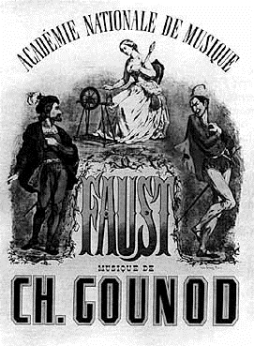 What Goethe did, among other things, was translate the myth of Faust from the Renaissance to the Romantic era. It was an incredible success. Translated all over Europe, it inspired musical works by Gounod, Berlioz, and Liszt. A young Gérard de Nerval translated Part One of Faust into French, and it has recently been argued that a previously-anonymous 1821 English translation of Part One is in fact the work of Samuel Taylor Coleridge.
What Goethe did, among other things, was translate the myth of Faust from the Renaissance to the Romantic era. It was an incredible success. Translated all over Europe, it inspired musical works by Gounod, Berlioz, and Liszt. A young Gérard de Nerval translated Part One of Faust into French, and it has recently been argued that a previously-anonymous 1821 English translation of Part One is in fact the work of Samuel Taylor Coleridge.
I think part of what made Goethe’s Faust so successful in its time (and beyond) was a shift in characterisation. Goethe made his Mephisto the most impressive and charming character in the book. This Prince of Darkness truly was a gentlemen, ironic, witty, and relentlessly clever. At times he even seemed to stand outside the story, commenting on events with a cynical detachment. Goethe created, or anyway crystallised, a new way to think about hell.
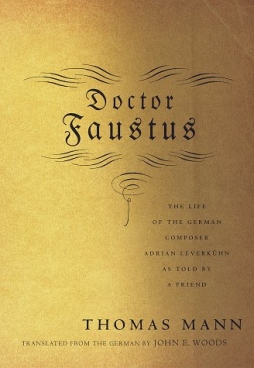 But how does the Faust story, bound so closely to traditional ideas of heaven and hell, of salvation and damnation, work in a much more secular society? Can it still have resonance? Of course; for proof, look at Thomas Mann’s novel Doctor Faustus, a post-World War II rumination on music, evil, and culture. It’s the story of a gifted composer, Adrian Leverkühn, as told by his often-flummoxed friend Serenus Zeitblom; the Faust story from the perspective of Faust’s knockabout servant Wagner, if you like, except Zeitblom’s a very different personality. Leverkühn believed in the supernatural, believes that he has made a pact with infernal powers; Zeitblom doesn’t, ascribing his friend’s visions to hallucinations caused by progressive syphilis. The book gives reason to accept both versions of events.
But how does the Faust story, bound so closely to traditional ideas of heaven and hell, of salvation and damnation, work in a much more secular society? Can it still have resonance? Of course; for proof, look at Thomas Mann’s novel Doctor Faustus, a post-World War II rumination on music, evil, and culture. It’s the story of a gifted composer, Adrian Leverkühn, as told by his often-flummoxed friend Serenus Zeitblom; the Faust story from the perspective of Faust’s knockabout servant Wagner, if you like, except Zeitblom’s a very different personality. Leverkühn believed in the supernatural, believes that he has made a pact with infernal powers; Zeitblom doesn’t, ascribing his friend’s visions to hallucinations caused by progressive syphilis. The book gives reason to accept both versions of events.
In the end, Leverkühn doesn’t escape his curse; he goes mad in the late 1930s. It’s a tribute to Mann’s writing skill that he makes the obvious parallel feel natural, inevitable. The book’s a high modernist take on a traditional popular myth; highly inventive, it’s also a classic of the twentieth century.
At the same time, though, the Faust myth was returning to its popular roots. You can find versions and variants of the Faust story everywhere, now, adapted to local conditions and ideals. Stephen Vincent Benét’s “The Devil and Daniel Webster” imagines Webster standing up to Satan over the soul of a farmer who dealt away his soul. Webster claims that “no American may be forced into the service of a foreign prince” — effectively investing the country with a theological authority over Satan. And Satan buys it, accepting the argument but claiming that he’s as American as they come, having been in America from the beginning. Webster then gives an oration claiming that in America “out of the wrong and the right … something new had come”, and Satan’s jury of the damned agrees; Webster wins his case, and the American Faust is saved. Theophilus in the sixth century was saved by faith in the Virgin Mary; Jabez Stone in the nineteenth was saved by faith in the United States.
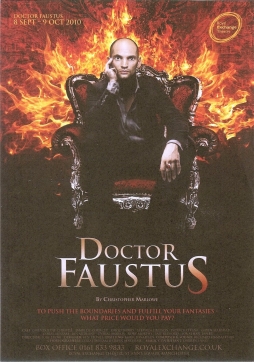 And Faust in the sixteenth? He was damned for insufficient faith; or else saved in part due to hell’s own cupidity. It’s all a question of what version you want, the Renaissance or the Romantic.
And Faust in the sixteenth? He was damned for insufficient faith; or else saved in part due to hell’s own cupidity. It’s all a question of what version you want, the Renaissance or the Romantic.
Historians now talk about the Renaissance era as the Early Modern period. I’ve always felt the term was misleading; to me, it seemed a time that had as much or more relation to the Medieval era preceeding it, in terms of mentalities and assumptions, than it did to the true modern world that followed it. The fifteenth, sixteenth, and a large part of the seventeenth century predated the scientific, rationalistic world that we live in now. It was a world based on religion, with the basic structure of life and indeed the physical environment understood as the product of a divine order.
But the Faust myth makes a compelling argument for the presence of the modern within the Early Modern. Not only in the sense that the story still makes basic emotional sense to us today. But Faust represents, in many ways, an early scientist. A man prepared to sacrifice God and the security of salvation to learn about the way the world really works.
The Europe of that time surrendered such Church-backed assumptions as the Ptolemaic belief that the sun moved around the Earth; Faustus was there before them, getting the low-down on celestial motions from Mephistopheles. The hierarchy of the great chain of being was undermined by the slow advance of science; Faustus was tweaking the Pope’s nose long before. The original form of the legend ended with Faustus damned — but by the early nineteenth century, Goethe had convincingly imagined a form of the tale in which Faust finds his eternal salvation.
What does Faust mean to us today? He’s a man who damned himself for power, but also for learning. He’s a warning about what happens when science displaces values. He’s a warning about getting into something without a way of getting out of it. He’s a warning about striking deals you don’t fully understand. He’s an object lesson in the process of damnation. But he’s also a symbol that nothing is inevitable: sometimes Faust is saved.
 The fact is, even back in the Renaissance there was a version of Faust that found salvation, through repentence and a deliberate forsaking of his magic art. This Faust had an unusual story, though; in the play where we follow his tale, he seems to create a narrative in which other characters are made to take their parts by his magic, acting out a peculiar fantasy, a comedy in the highest sense, which ends with his daughter married and he himself restored to a Dukedom he’d lost long before. For “Faustus” literally means “the favored one” in Latin; in Italian, that translates as “Prospero”.
The fact is, even back in the Renaissance there was a version of Faust that found salvation, through repentence and a deliberate forsaking of his magic art. This Faust had an unusual story, though; in the play where we follow his tale, he seems to create a narrative in which other characters are made to take their parts by his magic, acting out a peculiar fantasy, a comedy in the highest sense, which ends with his daughter married and he himself restored to a Dukedom he’d lost long before. For “Faustus” literally means “the favored one” in Latin; in Italian, that translates as “Prospero”.
Prospero and Faust are two sides of a coin: the saved wizard and the fallen. One who squanders his power, and frantically promises with his last words to burn his books; the other who sets his wizardry to work making things right for himself and others, and who in the end walks away, abjuring rough magic, breaking his staff and drowning his power. If Faust gives us a Renaissance image of a damned wizard, Prospero gives us the reverse. He’s not as broadly popular, perhaps, and his story is more complex; but by turning the Faust image inside-out, we find something just as fascinating.
III — Notes Toward a Taxonomy of Wizards
Thinking about Faust and Prospero, Renaissance images of the wizard, reminds me of a project I’ve toyed with from time to time: a taxonomy of wizards. I’ve had the idea for a while that wizards seem to fall into a relatively few types; that you can categorise them in a way that is perhaps more difficult with other kinds of characters. I’ve come up with some notes to suggest what I mean, different kinds of wizards that seem to me to account for must magic-users out there. If anybody can think of other kinds to add to the list, I’d love to hear it; these are only “notes toward a taxonomy,” not “a unified field theory of wizardry.”
A couple of notes to start: first, I mean “wizard” here to be non-gender-specific. Technically, the original meaning of the word is “wise man,” but meanings do drift over time, and I prefer the connotation of wisdom to more general terms like “magician.” Secondly, I would define a “wizard” as somebody who is actively involved with magic; a spell-caster who studies their art. A wizard may well have other goals than to become a great mage, but the wizard’s process of negotiation with magic and what magic means — as, for example, Faustus and Prospero negotiate the moral dimensions of their power and their risks of damnation — should go some distance toward defining the character.
Third, as should become immediately obvious, this is a taxonomy based on character types, not magic types. Alchemists, bards, ceremonial magicians, and any other type of spell-caster can all (in theory) be found in almost any given category. The point isn’t the means by which magic is done; it’s how magic helps shape the character. Fourth, I found it worth trying to make a distinction between wizards and characters that look like wizards but really aren’t: prophets, cult leaders, confidence men, and so on. The latter, I feel, don’t really belong on this list, with perhaps one notable exception. Some people may disagree. Each to their own.
That said, here are the types I could think of:
 For a while, I seriously considered the possibility that there were only two types of wizards: Wizards of the Tower and Wizards of the Road. Wizards of the Road would be Odinic wanderers, as Tolkien once described Gandalf; stormcrows, ragged creatures without homes, often found acting as mentors to less-interesting youngsters with some destiny or other. Wizards of the Tower would be traditional magicians, holed up studying lore and emerging only to work some wonder: Albertus Magnus, Friar Bacon, Prospero, Virgil (according to legend). It was an interesting theory, and I still think it’s a useful rule of thunb, but the more I thought about it, the more I found other archetypes.
For a while, I seriously considered the possibility that there were only two types of wizards: Wizards of the Tower and Wizards of the Road. Wizards of the Road would be Odinic wanderers, as Tolkien once described Gandalf; stormcrows, ragged creatures without homes, often found acting as mentors to less-interesting youngsters with some destiny or other. Wizards of the Tower would be traditional magicians, holed up studying lore and emerging only to work some wonder: Albertus Magnus, Friar Bacon, Prospero, Virgil (according to legend). It was an interesting theory, and I still think it’s a useful rule of thunb, but the more I thought about it, the more I found other archetypes.
Student Wizards, for example. Wizards learning how to control their magic. But then, one can break students down into students of the road or of the tower, too. A Student Wizard of the Road might wander all across the world to learn their craft — or across the sea that is the world, chasing their own shadow. A Student Wizard of the Tower might remain stuck at a boarding-school like institution, and still end up suffering through adventures and confrontations with dark lords because, frankly, that’s the sort of thing that happens to wizards whether they go travelling or not. They might as well get used to it while they’re young, I suppose.
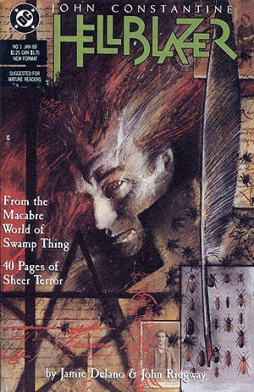 On the other hand, the Chess-Playing Wizards tend to operate behind the scenes. Their playing-boards are countries or worlds. A wizard like Merlin manipulates kings and knights for reasons of his own. Evil magic-using viziers are chess players. So are wizards embroiled in grand conspiracies. Aleister Crowley imagined himself as a Chess-Playing Wizard (consider his self-images in his novel Moonchild), but I don’t know whether that really came off. Though Grant Morrison tells us that he did manage to beat the founder of Arkham Asylum at chess.
On the other hand, the Chess-Playing Wizards tend to operate behind the scenes. Their playing-boards are countries or worlds. A wizard like Merlin manipulates kings and knights for reasons of his own. Evil magic-using viziers are chess players. So are wizards embroiled in grand conspiracies. Aleister Crowley imagined himself as a Chess-Playing Wizard (consider his self-images in his novel Moonchild), but I don’t know whether that really came off. Though Grant Morrison tells us that he did manage to beat the founder of Arkham Asylum at chess.
The Wizard Detective is a distinctive type of the past century or two. They may be known as ‘psychic detectives’. Algernon Blackwood’s John Silence is the classic example of this type of wizard, a slightly-more-supernatural Sherlock Holmes who investigates odd cases involving matters beyond mortal ken. Randall Garrett’s Lord Darcy would also fit the pattern; so would Harry Dresden. And I’d put that classic modern-day Wizard of the Road, John Constantine, squarely in this category, too.
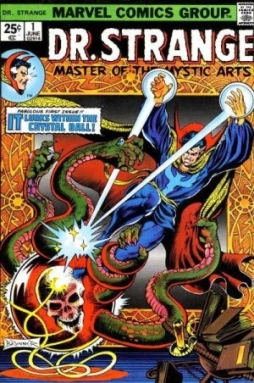 But Constantine suggests another category: the Super-Wizard. Mandrake the Magician was probably the first of these, men and women in costume who wield spells as a super-power and dress in a flashy costume. They’re relatively rare creations nowadays, but in the 1940s they were much more common: Zatara, the Spectre, Doctor Fate, and many others. There was even a comic called Super-Magician. I suspect the reason there aren’t as many of them being created today (other than a few notables like Wiccan from the Young Avengers or Nico from the Runaways) was due to the creation of a character who so completely embodied the archetype of the Super-Wizard that all the others seemed redundant: Doctor Strange. Not only is Strange perhaps the most powerful of this most powerful kind of wizard, he’s also got a powerful story behind him, one of the best origins in comics history. Plus, the artists who’ve envisioned his adventures have been, on the whole, stunning: Steve Ditko, Gene Colan, Frank Brunner, Mike Mignola, Paul Smith, and P. Craig Russell, just to name a few off the top of my head.
But Constantine suggests another category: the Super-Wizard. Mandrake the Magician was probably the first of these, men and women in costume who wield spells as a super-power and dress in a flashy costume. They’re relatively rare creations nowadays, but in the 1940s they were much more common: Zatara, the Spectre, Doctor Fate, and many others. There was even a comic called Super-Magician. I suspect the reason there aren’t as many of them being created today (other than a few notables like Wiccan from the Young Avengers or Nico from the Runaways) was due to the creation of a character who so completely embodied the archetype of the Super-Wizard that all the others seemed redundant: Doctor Strange. Not only is Strange perhaps the most powerful of this most powerful kind of wizard, he’s also got a powerful story behind him, one of the best origins in comics history. Plus, the artists who’ve envisioned his adventures have been, on the whole, stunning: Steve Ditko, Gene Colan, Frank Brunner, Mike Mignola, Paul Smith, and P. Craig Russell, just to name a few off the top of my head.
If the Super-Wizard uses a particularly high-powered kind of magic, the Faustian Wizard gets power at a terrible price. What that price is may vary. But the nature of the Faustian bargain is to get something of value at a price far beyond its worth. The Faustian Wizard is not necessarily a bad guy, but is heading to a bad end.
The Sinister Wizard, though, is just bad news. Even if they’re only sitting around at Firetop Mountain, they have plans afoot which bode no good for anyone. Archimago from The Faerie Queene is the perfect example of a sinister wizard, an endless source of wicked plots and evil deeds. Usually these characters are antagonists, but there’s at least one I can think of that sometimes plays the hero.
 The Fighter-Magic-User (to borrow a venerable term) is a rare beast, but memorable. Elric of Melniboné is perhaps the classic example of a character adept with both sword and spell, but the Gray Mouser isn’t far behind. The Lady from the Black Company books would qualify, when she wasn’t being a Sinister Wizard. On the other hand, the Mouser could also be seen as a Wizard Rogue, a Wizard who turns to magic to help him with some kind of scheme — only to find it’s not that easy to turn away from magic afterward. Alodar from Master of the Five Magics is an example; so’s Skeeve from the Myth books. Many of these wizards are close to being frauds; the best example, I think, is Oz, the Great and Powerful.
The Fighter-Magic-User (to borrow a venerable term) is a rare beast, but memorable. Elric of Melniboné is perhaps the classic example of a character adept with both sword and spell, but the Gray Mouser isn’t far behind. The Lady from the Black Company books would qualify, when she wasn’t being a Sinister Wizard. On the other hand, the Mouser could also be seen as a Wizard Rogue, a Wizard who turns to magic to help him with some kind of scheme — only to find it’s not that easy to turn away from magic afterward. Alodar from Master of the Five Magics is an example; so’s Skeeve from the Myth books. Many of these wizards are close to being frauds; the best example, I think, is Oz, the Great and Powerful.
And then there’s the Failed Wizard. The wizard cast down from the heights of power; or the wizard sadly blocked off from ever reaching it. Rincewind in the Discworld books is a good example. So’s Jemidon from Secret of the Sixth Magic.
Nine or eleven different types of wizards, depending on how you count it. This accounts for all of the wizards I’ve been able to think of, but I suspect there are more. I throw this out to any reader who cares to answer: what am I missing?
Matthew David Surridge is the author of “The Word of Azrael,” from Black Gate 14. His blog is Hochelaga Depicta.
Cheer Your Wizards…
[…] playing practical jokes on the Pope, calling up the spirit of Helen of Troy, int […]…
I would propose the addition of domestic wizards, who are a particular specialty of Robin McKinley’s, though I think I can dig more up with a little time. Some domestic wizards might also be described as student wizards whose studies haven’t started yet (like the title character of McKinley’s Sunshine), or as failed or disillusioned wizards, whose place of retirement happens to be homey (like Sahath in”The Healer”), but any literary taxonomy will be complicated by overlaps.. McKinley’s recurring, multiverse-spanning character Luthe might also appear to be a wizard of the tower, except that his tower, which is more like a barn, usually functions as a convalescent house for wounded princesses Luthe mends up so they can go back out to meet their heroic destinies.
Related to Sarah Avery’s ‘Domestic Wizard’ is what I’d call the Village Wizard. The Village Wizard is a person – usually but not always a woman – who uses spells, herbs, talismans, etc, to see to the day-to-day health and prosperity of a small community of common people (though this community could be, say, a 10th c. Baghdad or 17th c. London neighborhood rather than an actual village). I’d argue that this sort of wizard actually accounts for the vast majority of ‘real’ practitioners of magic throughout history, even if she rarely appears as a hero in fiction.
I like both of these ideas, though they seem close enough to me that they could probably make up one type between them. I actually did consider “The Hedge Wizard” as a possibility, with the same general idea as what you both are talking about here.
[…] for years, my interest was first rekindled by Matthew David Surridge’s long article “The Scar-Crow Men, Faustus, and Wizards: Three Posts,” in which he talked about several types of supernatural investigators, including the Wizard […]